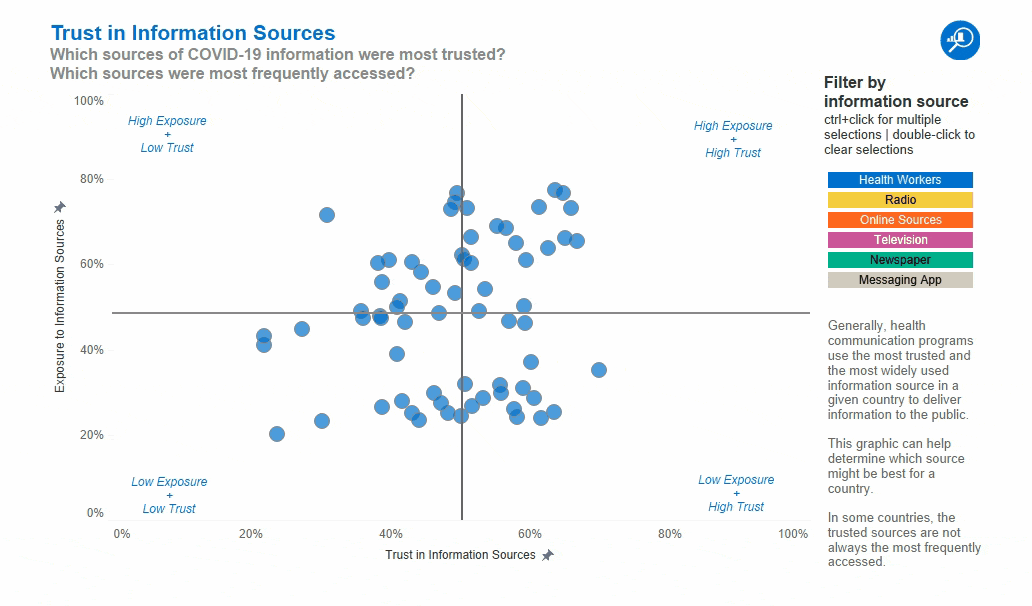When it comes to taking precautions to prevent COVID-19, 87 percent of Americans say they wear masks, but many (31 percent) don’t believe others in their communities are doing the same.
These findings come from global COVID-19 behavior surveys conducted in July in 67 countries from more than 300,000 people who chose to participate in a survey promoted on Facebook. Researchers from MIT collected the data and the Johns Hopkins Center for Communication Programs analyzed and presented the data on an easy-to-use dashboard released today. This study of knowledge, attitudes and practices around COVID-19 is a collaboration among CCP, Facebook Data for Good and MIT, and the World Health Organization and Global Outbreak Alert and Response Network served as advisors.
“This data will be extremely valuable to public health programmers across the globe who are trying to figure out the best way to protect their people from the COVID-19 pandemic that continues to claim thousands of lives a day,” says Susan Krenn, CCP’s executive director. “Until we have a safe and effective vaccine, behavior change is the only tool we have to stem the spread of the virus. This COVID dashboard will help us more efficiently focus our behavior change efforts.”
COVID-19 has sickened nearly 30 million people around the world this year and killed nearly one million, including nearly 200,000 in the United States, which has the world’s largest outbreak.
Today marks the first wave of analyses from the KAP COVID dashboard. More data will be released over the next several weeks, data that will allow policy makers and public health programmers to dig much deeper into the knowledge, attitudes and practices of their individual countries as well as make more comparisons between countries. In some countries, data will continue to be collected until October and the dashboard will be updated as that data becomes available.
The data reveal different rates of preventive behavior uptake across all 67 countries. One set of questions in the survey digs into behaviors that have become social norms since the pandemic began. In some regions of the world such as Asia, mask wearing quickly became nearly universal, likely because those nations have dealt with severe disease outbreaks in recent years, such as the SARS epidemic in 2003, and mask wearing is generally more accepted.
Although mask wearing is generally quite high in most countries, with 96 percent of people in Japan, South Korea, South Africa and Spain reporting they wore a mask in the prior week, there are anomalies. In the United Kingdom, for instance, reported mask wearing was only 66 percent, in the Netherlands only 38 percent and, at the lowest end of the scale, at 18 percent in Estonia. Like mask wearing, reported handwashing behaviors are also quite strong, whereas physical distancing behavior was less prevalent, with a wider range across countries from 35 percent in Mongolia to 92 percent in Australia.
A key finding is that while many people say that they have adopted these key prevention behaviors, in many countries they don’t believe that their neighbors are doing the same.
The majority of the people in United States, for example, say they practice social distancing (80 percent) but, as with mask wearing, many don’t think those are norms in their community (40 percent think most people in their community don’t maintain proper physical distance from others).
“The reason for this gap between practice and perceived norms is not yet clear,” says Doug Storey, PhD, director for communication science and research at CCP. “High reported mask wearing could reflect response bias—people may exaggerate their own behavior because they don’t want to appear negligent.
“Perceived norms, on the other hand, are usually determined by what people observe others doing, so low perceived norms might reflect the fact that people are isolated at home and don’t have many opportunities to see what others are doing in public. And some people may have lower expectations of others as a result of the prominence of anti-masking demonstrations in the media.”
Meanwhile, many who say they are wearing their masks and keeping their distance from others say they are not confident that their actions will actually prevent COVID-19.
In Nepal, for example, 51 percent of people said they believed they could control whether they get COVID-19 (one of the highest percentages of any country). Still, 72 percent practiced physical distancing and 88 percent wore masks to prevent COVID-19.
There is also a wealth of data on fear of infection. In Vietnam, 89 percent of respondents said they believed COVID-19 is a dangerous threat to their community, while in Poland, the figure was just 12 percent. In the United States, that number is 48 percent.
The KAP COVID dashboard also contains a section on trusted sources of information. During any public health emergency, it is vital for people to trust the information that they see and for that information to actually be trustworthy.
When it comes to getting news about COVID-19, 88 percent of Americans say they use online sources for the latest information but just 11 percent say they actually trust what they learn there.
This lack of trust in a major source of information suggests that public health officials should adjust their tactics if they want to ensure the U.S. public is getting the correct messages about COVID-19 prevention methods such as handwashing, mask wearing and physical distancing.
Other sources of information score better, such as television. In many countries, meanwhile, health care workers are considered the most reliable sources of information related to the virus, but access to health care varies considerably by country and community.
To improve acceptance of key prevention information, officials could consider finding ways to get health care workers more involved in media campaigns, by directly delivering messages or reinforcing them through media outlets, to boost credibility.
“If you’re a public health programmer, this information will help you select trustworthy sources and identify gaps in knowledge to tailor messages appropriately,” Krenn says. “The whole goal is to help people understand and practice the behaviors that will prevent them from getting sick with, and spreading, COVID-19.”
To learn more about how to best use the dashboard, CCP, WHO, GOARN and Facebook Data for Good will be hosting a webinar, Global Knowledge, Attitudes and Practices around COVID-19: A Close Up Look at the Data, at 8 a.m. EDT on Wednesday, Sept. 30. For more information about the webinar and to be apprised of new data uploads to the new COVID dashboard, please join our mailing list.






